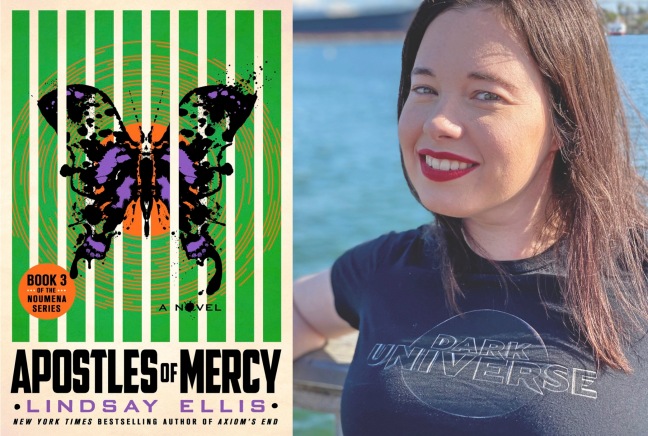First contact between humans and extraterrestrial intelligence is a natural and perennial playground for science fiction readers and writers. There’s always room to explore, and in her Noumena Series, Lindsay Ellis provides readers with all the reasons. Newly-imagined aliens, compelling characters with rich voices, stories and back-stories and fresh new science are deep in the weave of the three (of five projected) novels. What Ellis does with all this great material is to wrap it in a narrative that manages to be fun and thought provoking. It’s a tough job to make readers laugh out loud while inducing serious speculation about life itself. Ellis is up to the challenge.
The first book, Axiom’s End, sets up tone and content. It’s 2007. Cora Sabino is the cast-off daughter of a Julian Asange-like figure. Two “meteors” arrive in the hills outside of LA, and Cora sees the occupant of one of them. It’s a nine-foot high nightmare, a 942 year-old bio-mechanical intelligence that might be unable or unwilling to communicate with humans. It’s a serious and scary setup as seen by a sarcastic SoCal gal. Briskly paced, packed with action and fascinating ideas about language and intelligence, Axiom’s End manages to go where you least expect, creating an alternate history of the recent past.
Truth of the Divine follows on directly from Axiom’s End. The alien character, Ampersand, and Cora are, with the rest of humanity, confronting the reality of intelligent, space-faring life in the universe. This time around, Ellis dives deep into character. Cora becomes even more sympathetic, Ampersand remains engagingly un-human, and the relationship between the two offers the readers humor that serves to emphasize the speculation and extrapolation that are the core of science fiction. The alternate history unfurls in a conversation with actual history. Pacing here is also excellent on every level; within individual scenes, in the subplots (and new characters) that move the book, and in the novel as an episode of the series.
And this brings us to the brand-new entry, Apostles of Mercy. Once again, Ellis makes what’s very difficult feel and read very easy. In a page-turning, action and tension packed narrative, Ellis externalizes difficult internal debates; immigration, right-to-death (the aliens choose the day of their death), culture clash, truth and lies. We meet more sorts of aliens in scenes that are horrific, heart-rending and humorous. Ellis knows how readers have fun, and that humor can lead some to very knotty questions that are not easily, if at all, answered. Her ability to combine readability with thinkability is inspired. In each novel, she manages to tell a complete story even as readers are left wanting more. Given the breadth and depth of her achievement thus far, Lindsay Ellis is clearly a major new talent for the science fiction genre. And given the Noumena series thus far, readers can engage in their own enjoyable extrapolation about what’s to follow, and anticipate their own surprise. These are the good old days.
Since I managed to miss the first two books in this series when they first came out, I indulged in binge reading. I highly recommend this approach. In speaking with the author, we took the long view of all three novels. Here’s the download link for our conversation, or listen below, as the audio assures no eye contact or in person presence. To quote Firesign Theater on First Contact, “If there are eyes, avoid eye contact. If there are no eyes, avoid all contact.”




